Friday, March 07, 2003 :::
Welcome to my garden. Won't you follow me on a brief tour of the April beds of a few years ago. Since I am about to completely replant most of these beds this may be your only chance to have a look at the garden that was.
I've been growing this garden in incarnation of another since 1983. Some years I've added to it, and some years I've merely replanted it. Nearly every year I've held a party in it. A garden is a live thing that must be given a chance to grow and adapt, to fulfill itself within its own geography and to meet the longings of the people who wander its paths. What once was a Mel Bartholomew square foot vegetable garden has existed as an herb garden, a rose garden and now a weed garden - but with pleasing bones that can be worked into a new life as a flower and dyers garden.
These first photos come from April 1997. There are literally thousands of photographs of my garden but for some reason that year the pictures seem to be the prettiest. I'll be posting two more "tours" in the near future, one of May 1997 and another of the Garden Party from either 1999 or 2000.
So - won't you join me on a tour?
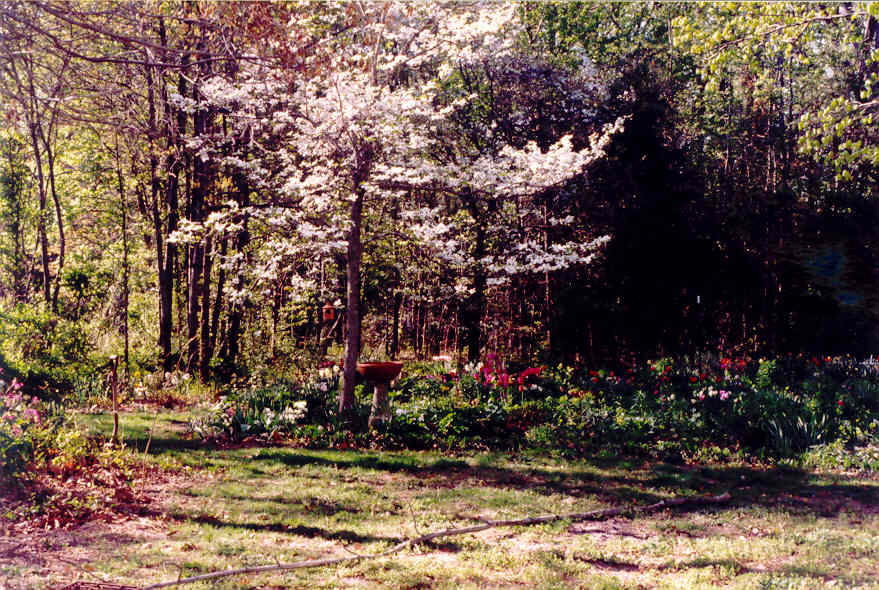
This is the dogwood path - one of the entrances to the Birthday Garden. That it is in bloom means it is April. This whole garden was wrested from scrub and cutover pine tree forest by my lily-white hands with some high quality help from a group of the county's nicest boys. (Including DS). As each new generation comes along there is always a 12 year old who is happy to earn $5.00 an hour working with rake, hoe and pitchfork.
This particular planting contains not only some lovely purple azaleas and glowing tulips, but also one of 4 Burkwood virbumums. I first came across them growing in the parking lot of the Virginia Museum of Fine Arts. We frequently visit this museum in April on our anniversary and they are always in bloom. Their fragrance is heady and intoxicating and I was determined I would have bouquets of them in my home.
Just beyond the thin woods at the back of these beds is a large crop field - sometimes planted in corn, sometimes in beans, sometimes in wheat.
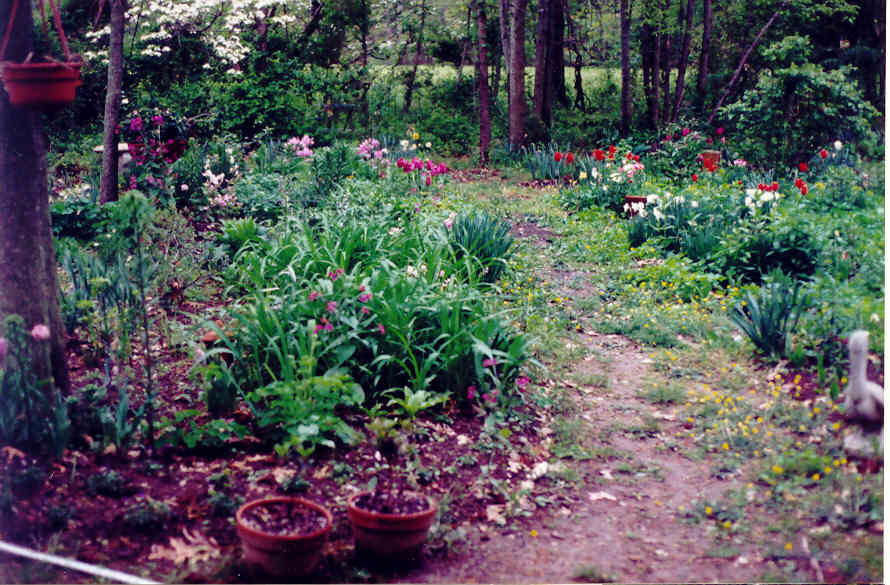
Here is the same bed, but from the other side, still looking west towards the fields. Here you can see my weed of choice - violets. I let them spread everywhere and they give the garden a finished look in April. They are so rampant that I can dig them up and toss them into the woods whenever I need space to plant something. The white flowers to the right are Thalia daffodils which are considered fragrant, though I don't like their scent. I do like their color, their daintiness and their hardiness. The pink in the right foreground is Lunaria annua or money plant or Honesty. These all came from my mother-in-law's gardens overlooking the riverbank in town. They are all over the yard and the edge of the forest.
Do note, the other weed, though not as welcome, is buttercup. We have it out now and then, but in the end it will win.
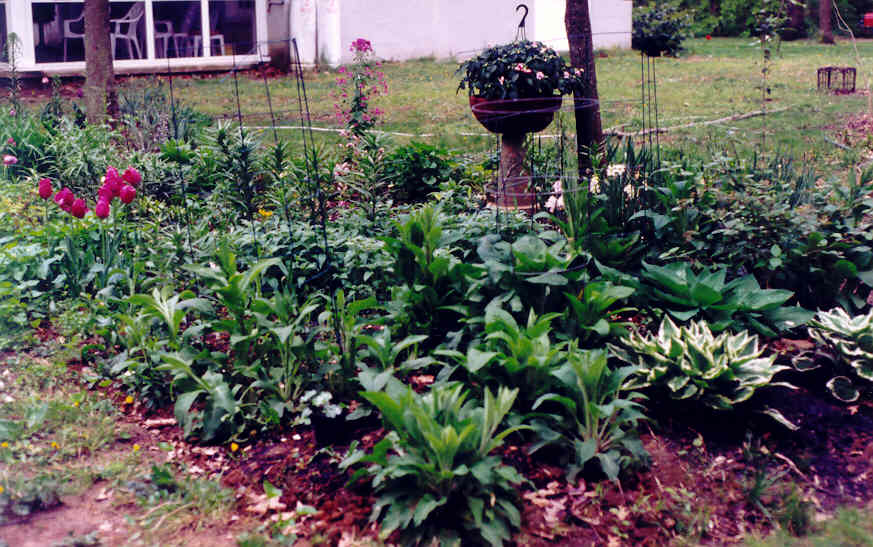
Here is another view of this same bed, but looking east, towards the house. The tomato cages are for the foxgloves that will come later. In the planter is a cluster of rosebud impatiens. I adore foxgloves. My favorite story of how they got their name because the fox puts a little paw print inside the throat of each one. Here is another one.
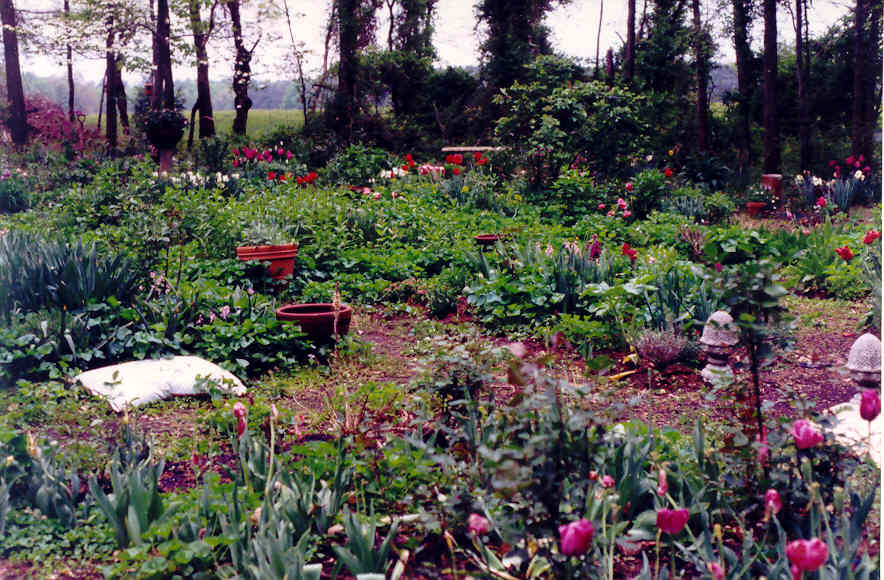
This is a little later in the tulip season, again, looking west, though from deeper into the garden. The pineapples mark the entrance into what I call "The Old Garden" - the original 4-square-beds-around-a-circle that was supposed to be my colonial herb garden. It's had many incarnations and will surely have many more. The lighter green is the violet foliage. It's lush and welcome through about mid June and then it begins to get leathery, and even burn a bit, in our hot southern summers. These leaves are good salad additions, with a high vitamin C content. There is a path right behind the foremost pot that takes you back to the Dogwood bed. The bench in the back, against the fringe of trees is one of two, in what is called "The New Garden". This is not really the newest garden. It took a long time to get that spot of ground cleaned up and for once I had the patience to keep the entire series of beds in buckwheat all summer. Not only did that help tremendously with soil conditioning, but also it gave me an opportunity to see what the sun did to those beds - which was mostly hide from them. They were supposed to be additional rose beds but I realized they were too shady and so they became a different sort of garden - lots of bulbs, a few azaleas, more Burkwood viburnums, and some wild roses that I knew would grow in this semi-shady place. They have leapt and tumbled all up and over some scrubby trees and produced the prettiest wall of color. The spent daffodils to the front left of the picture are Mount Hoods. I absolutely love them and these are particularly special since my dad bought them and shipped them to me.
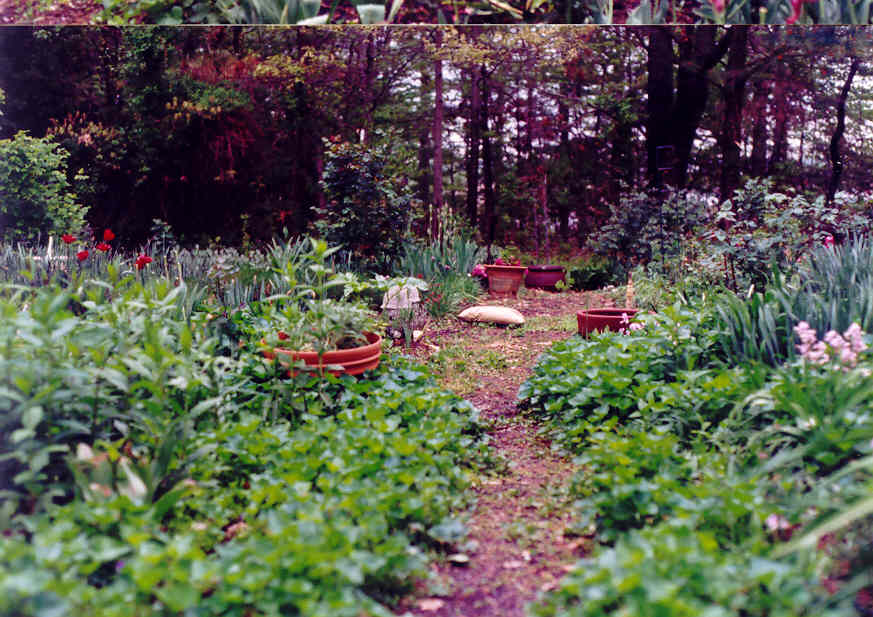
This shot was taken the same day. It's a view looking north. Through the forest in the back is a bank that slopes down to a salt marsh and a wide shallow bay, formed by several tidal creeks. Someone once chased a bear across those marshes and up the bank. Fortunately he didn't come across the yard. That was in pre-garden days when I was living in the yurt with my new baby and almost new husband.
The kettle at the end of the path has a crack in it so it can't be used for cooking but it's a great planter. We bought it at Flippo Hicks' antique shop the first year we were living here - gosh - 28 years ago. The bluish green foliage to the right of that pot is Abraham Darby - one of the best of the David Austins . The tall bush just behind the pineapples is Othello, another DA winner. 12 of his blossoms will make a small batch of Rose Petal Jelly. Just to the left of the red tulips is an iron sundial my beloved father-in-law made when he was at VPI in the 1920's.
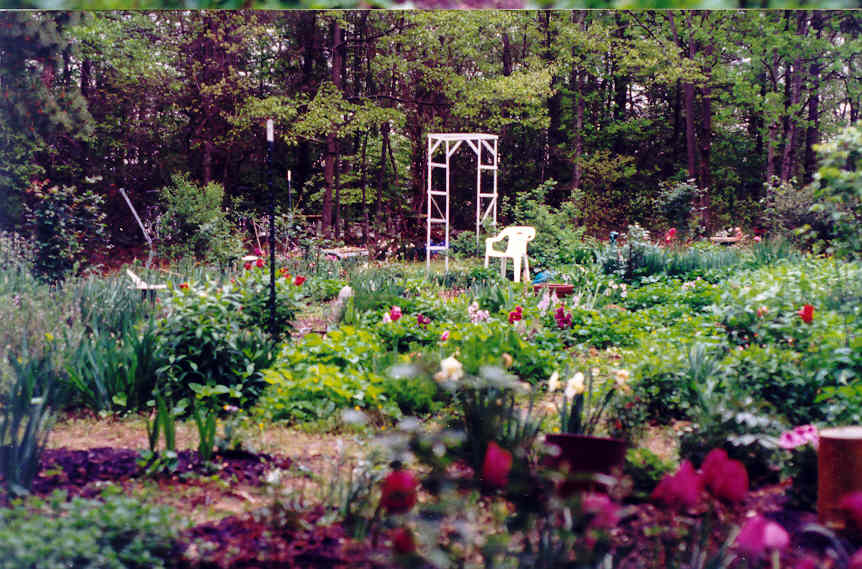
Here I've turned and faced east and you can see it is still the same day. DH made the arbor as a mother's day gift. The birdbath has a little clay angel sitting on its rim. She was a cutie but I believe she is broken now. The lighter green shrub on the left side of the picture is a lilac that overwintered at a nursery and then was sold at half price. She's very happy, thank you - and blooms reliably each spring. I see there are still a few Salome daffodils blooming in the foreground. Must have been a nice cool spring.

Here is a close up shot of greens and red. But that light yellow green blossom is a curse in my garden. I saw it growing in Agnes Ware's yard and commented on its beauty. "It's called Basket of Gold" she told me and gave me some. In my ignorance I eagerly planted it in the garden and it took off like wild fire. And what is it? From the family Euphorbiaceae - commonly known here as spurge. I call it "Euphorbia Pestilentia". I probably spend 100 hours a year digging it out. It is a grand plant if you have a bank with an erosion problem, but lord help you if you ever let it get into your beds.
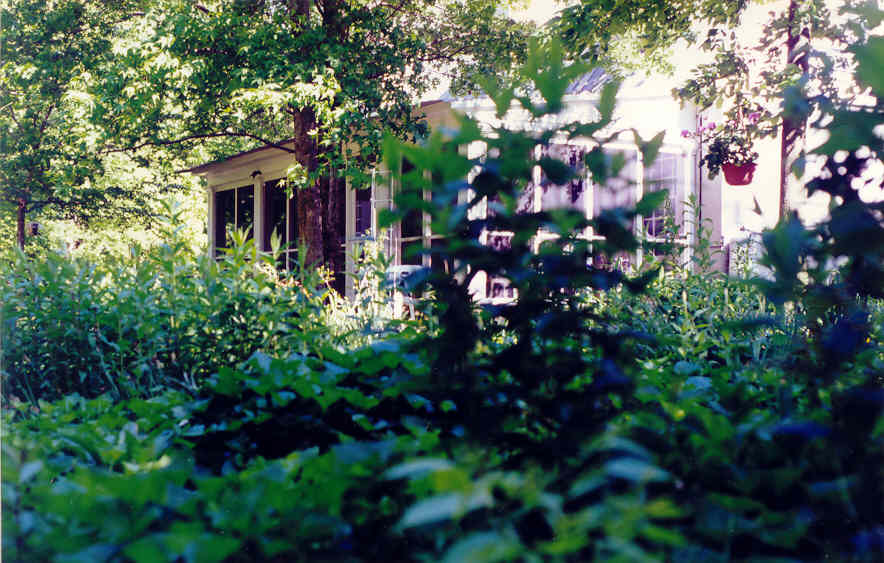
Here is more greenery. Lots of phlox growing tall. It's not much of a shot but I love the way the porch looks through the screen of leaves.

Here are the foxgloves singing in the shade. They are at a leafy doorway between the "New Garden" and the "Shade Garden" which is the most recent garden I've built - and the last one I will build. I have reached critical mass when it comes to square footage and know I can't take care of any more. This is a lovely garden though - the best thought-out of them all. It has hydrangeas, azaleas, camellias, candytuft, creeping phlox and some of those invasive roses from Japan called ... bah I'll have to look that one up.
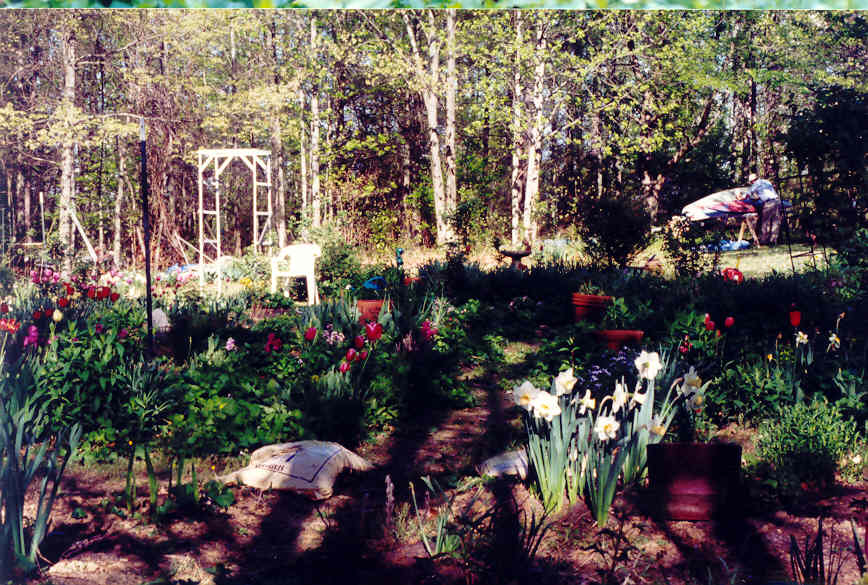
Here is another shot of the garden looking from the New Garden, east across the Flower Garden. That is the Captain, working on his boat - an old one we no longer have. It was a cute little trimaran called a Sunbird, I believe. We BoatBimbos don't keep track of boat info but that was the first sailboat we ever owned that I actually enjoyed. It had only room enough for one person in the cockpit and two big hammock beds for bimbos to sunbathe on and it was too small to take out overnight so you could always get back to the garden by sundown.
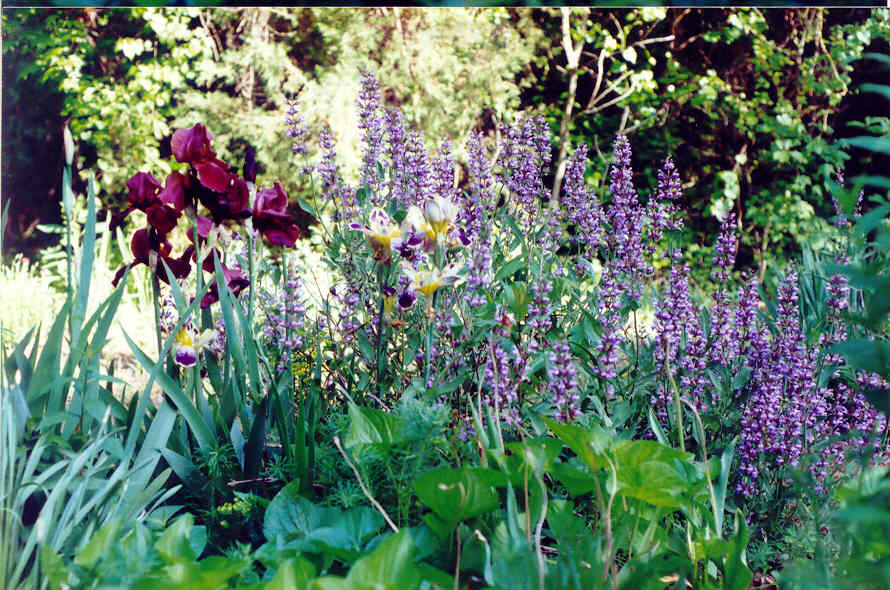
This is one of two beautiful sage plants that stand at the west of the Old Garden, opposite the two cement pineapples, which guard the east entrance. The Iris are antique species but I am afraid I haven't any of my garden notebooks with me so I can't remember what either of them are named.
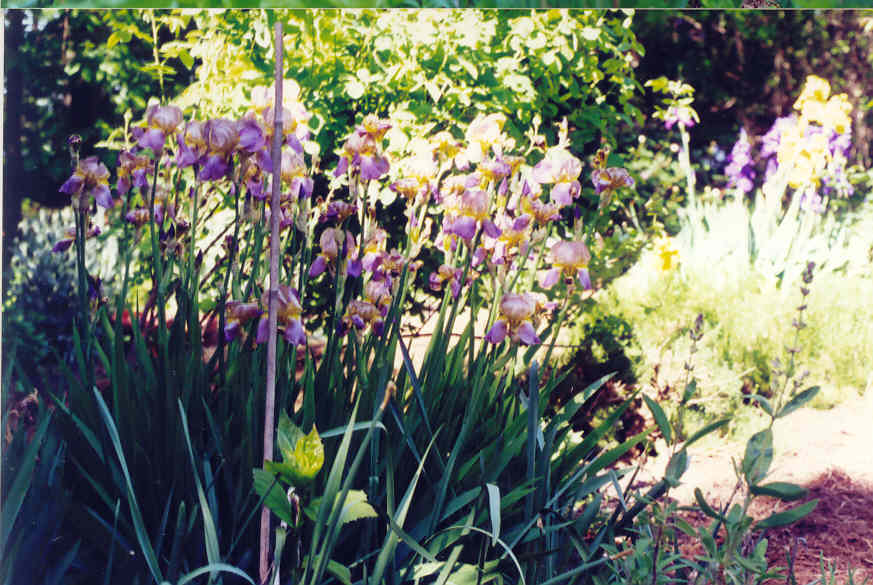
This last shot of the gardens in April is of a planting of Quaker Ladies, an old strain of iris popular in colonial days. You will find them growing in many historic gardens, but mine were a gift from Lois. They are planted in the Old Garden in the northwest corner bed - actually right behind the other large sage plant.
::: posted by Bess at 12:52 PM

